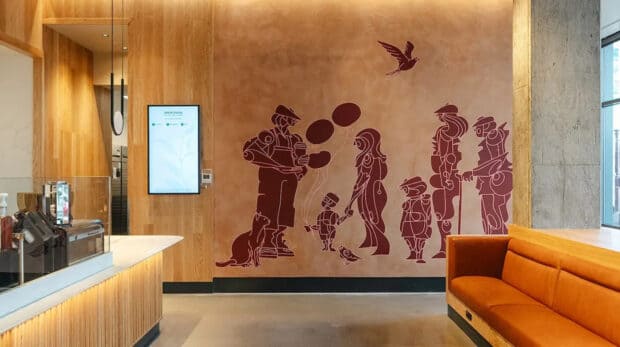[[{“value”:”
Starbucks Coffee Company late last week introduced a new framework for making its stores more inclusive for guests and staff with disabilities.
The first real-life manifestation of the new design framework, called the Inclusive Spaces Framework, came with the opening of a new Starbucks store in Washington D.C.
Starbucks said the inclusive design framework will be embedded in all new U.S. store designs moving forward, as the company seeks rapid domestic expansion. At the company’s most recent earnings call, CEO Laxman Narasimhan said Starbucks is planning to add approximately 4% more U.S. stores this year from its existing base of 16,000 company-owned and licensed locations. That would equate to approximately 640 new stores this year.
Given Starbucks’ vast market and cultural influences, its new design framework is likely to reverberate throughout the U.S. retail coffee industry, offering examples of how to build more inclusive stores.
The nuts and bolts of the inclusive framework are laid in this project summary, and further in this checklist designed for Starbucks store operators. The company has created three tiers of “achievement” within the inclusive store framework, identified as A, AA and AAA, with AAA being the highest level.
Highlights in all new stores under the framework include:
A redesigned point-of-sale system with portability, adjustable angles for visibility, a more intuitive layout, voice assistance, screen magnification and additional visual cues;
customer order status boards providing visual updates on drink orders;
power-operated doors whenever possible;
optimized acoustics and lighting to reduce background audio and visual interference;
more inclusive equipment design, including larger buttons and dials on the Starbucks Clover Vertica brewer;
unobstructed travel paths and improved counter heights with overhangs.
“At Starbucks, we have challenged ourselves to imagine what’s possible when we take a closer look at the many ways our partners and customers interact with us and experience our stores every day,” Katie Young, Starbucks senior vice president of store operations, said in an announcement of the new framework. “Building and scaling an Inclusive Store Framework is central to our mission of connection and will lead to greater access for all.”
On the same day Starbucks unveiled the new framework, a coalition of labor organizations asked the Securities and Exchange Commission to force the company to disclose the costs it has incurred in its anti-unionization efforts, which the group estimated to be $240 million.
Approximately 380 of the more than 9,600 company-owned and operated Starbucks stores in the U.S. are unionized. As of this writing, there have been zero ratified union contracts between Starbucks and unionized employees.
Comments? Questions? News to share? Contact DCN’s editors here.
“}]]


